C/2011 F1 (LINEAR)
2011/03/20
2011/03/21
2011/05/24
- IAUC 9202, issued on Mar. 21 2011,
announced the discovery of a new comet in the course of the
LINEAR survey via
their 1.0-m f/2.15 reflector + CCD, on images obtained on Mar. 17.3 2011.
Previously temporally designed BY58897, the new comet is now designated
C/2011 F1 (LINEAR).
-
2011 May 24
| Pixel size: 0".90 x 0".90 |
MPC observation computed with Astrometrica
using UCAC-3 star catalog in R band:
- COD C42
OBS X.Gao, M.-T. Hui
MEA M.-T. Hui
TEL 0.36-m f/6.9 Schmidt-Cassegrain + CCD
NET UCAC-3
CK11F010 KC2011 05 24.74959 11 30 50.80 +63 51 46.2
17.3 N C42
CK11F010 KC2011 05 24.76622 11 30 50.64 +63 51 39.0
17.4 N C42
----- end -----

-
- Gauss curve produced by
Astrometrica with USNO-A2.0. The total PSF is using an aperture circle of
5 x
5 pixel around the brightest
pixel. We can see the Gauss curve
in the right is as the computed ideal line and the
real pixels contributed around the ideal line. The Fit RMS,
which inlays under the Gauss curve, is the deviation from the
ideal line.
-
- Photometry result computed with FOCAS II,
which processes images based upon the .LOG file of Astrometrica, by means of
Multibox method:
- COD C42
CATALOG: USNO A2.0 / CMC-14 - BAND: R
10x10 20x20 30x30
40x40 50x50 60x60
SNR SB
COD
OBJECT DATE
TIME +/- +/-
+/- +/- +/- +/-
N FWHM CAT
------------ ---------- -------- -----
----- ----- -----
----- ----- ----
---- ---
C/2011 F1 24/05/2011 18:11:23 16.49 15.89 15.46 15.09 14.75 14.43 12.9 20.7 C42
C/2011 F1 24/05/2011 18:11:23* 0.04
0.07 0.09 0.07
0.07 0.07
2 3.5 USN
FoCAs II - 17/03/2010
www.astrosurf.com/cometas-obs
es.groups.yahoo.com/group/Cometas_Obs
- Interpretation of the FOCAS II table
headings:
-
-
- Fisrt line:
-
- OBJECT,
DATE, TIME: refering to their original meanings respectively
-
- 10x10,
20x20 ... 60x60: the aperture sizes of photometry in term of
rectangle in arcsec that are used to measure an object's magnitude
-
- SNR:
the Signal-to-Noise Ratio for aperture photometry
-
- SB:
stars of faintest magnitude on the images used in data reduction with
the used star catalog in Astrometrica, rather than the stars of faintest
magnitude in the images
-
- COD:
MPC Code of the observatory
-
-
-
- Second line:
-
- +/-:
precisions of measurement
-
- N:
the number of used images for measurement
-
- FWHM:
Full-Width-Half-Maximum of total PSF, relevant to degree of seeing
-
- CAT:
the used star catalog in Astrometrica
-
-
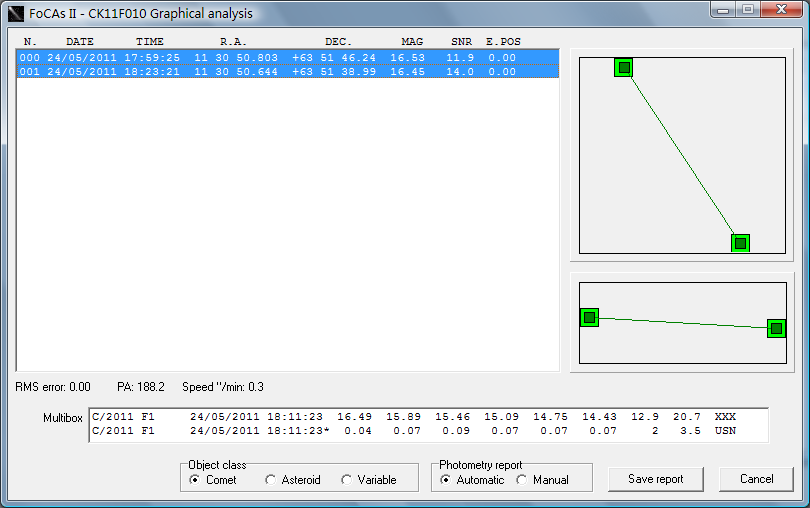
-
Copyright © Man-To
Hui
2011/05/27
2011 Mar 21
|
2011/03/21 14:38:48 UT
- 15:17:23 UT, 14" SCT f/6.9 + QHY9 CCD, BIN 2x2 90 sec x 12
exposure, north up and east left |
The following image
is 10x resized in order to extract details of the object. As a
result of no or slight interference from moonlight when we obtained
the images, its cometary characteristics appear more obvious; the
faint elongation is much more convincingly evident. Based upon
scrupulous analysis of this stacked image, I obtain potential coma's dia. 8",
and a tail in length of 6" in P.A. 252° approximately.
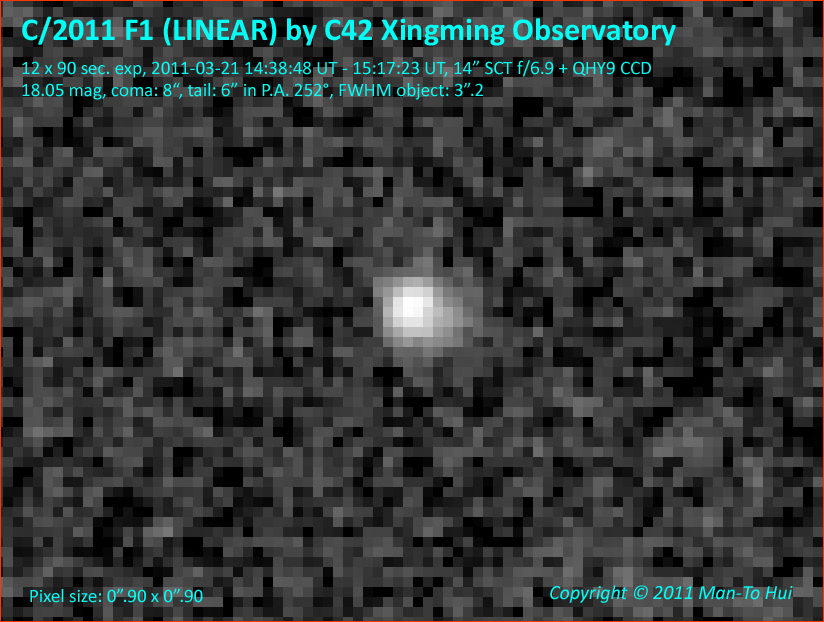
MPC observation computed with Astrometrica
using UCAC-3 star catalog in R band:
- COD C42
OBS X.Gao, M.-T. Hui
MEA M.-T. Hui
TEL 0.36-m f/6.9 Schmidt-Cassegrain + CCD
NET UCAC-3
CK11F010 KC2011 03 21.61198 12 16 24.50 +67 16 38.8
18.3 N C42
CK11F010 KC2011 03 21.62013 12 16 24.02 +67 16 39.9
18.6 N C42
CK11F010 KC2011 03 21.62847 12 16 23.46 +67 16 40.6
18.0 N C42
CK11F010 KC2011 03 21.63642 12 16 23.00 +67 16 41.5
18.6 N C42
----- end -----
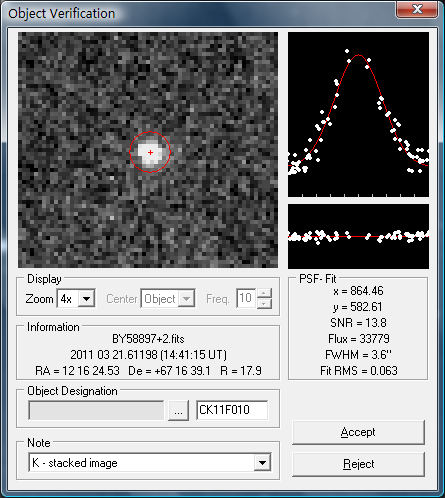
-
- Gauss curve produced by
Astrometrica with USNO-A2.0. The total PSF is using an aperture circle of
5 x
5 pixel around the brightest
pixel. We can see the Gauss curve
in the right is as the computed ideal line and the
real pixels contributed around the ideal line. The Fit RMS,
which inlays under the Gauss curve, is the deviation from the
ideal line.
- I try to compute a seemingly appropriate
orbital solution for comet C/2011 F1 (LINEAR) by feeding our own astrometrical
measurements and measurements from other stations and observatories, totally
141 observations (10 or 9 of them rejected in two following corresponding
cases), to FindOrb.
-
- Here come my two reasonable solutions:
-
- [1] Constraint e=1
-
- Orbital elements:
C/2011 F1
Perihelion 2013 Jan 19.625871 TT; Constraint: e=1
Epoch 2011 Mar 22.0 TT = JDT 2455642.5 Earth MOID: 0.6655
q 1.65141945 (2000.0) P Q
M(N) 5.8 K 10.0 Peri. 196.46461 0.07411425
-0.54685754
Node 85.18625
-0.79435110 -0.53794889
e 1.0000000 Incl.
56.81322 -0.60292072
0.64152772
From 141 observations 2011 Mar. 17-21; RMS error 0.522
arcseconds
# State vector (heliocentric ecliptic J2000):
# -3.574733475992 2.276024636264 5.738261811547 AU
# 2.988401521503 -6.689698016414 -5.411251140232 mAU/day
# MOIDs: Me 1.1987 Ve 0.9477 Ea 0.6655 Ma 0.2152
# MOIDs: Ju 3.5862 Sa 5.8305 Ur 8.0742 Ne 6.7032
# Elements written: 22 Mar 2011 13:53:37 (JD 2455643.078900)
# Full range of obs: 2011 Mar. 17-21 (151 observations)
# Find_Orb ver: Oct 11 2010 13:08:42
# Perturbers: 000001e0
# Tisserand relative to Earth: 1.98955
# Tisserand relative to Jupiter: 0.87220
# Tisserand relative to Neptune: 0.36282
# Vis:
C/2011%20F1&Epoch=20110322.000000&M=360.00000&e=1.0000000&a=-54369166.9016188&Peri=196.46462&Node=85.18625&Incl=56.81323&Eqnx=2000.0
# SkM:
&OE_EPOCH=2455642.500&OE_EC=1.000000&OE_QR=1.651419&OE_TP=2456312.125871&OE_OM=85.186254&OE_W=196.464618&OE_IN=56.813228&OE_H=5.7
-
- [2] Auto-solve mode:
-
-
Orbital elements:
C/2011 F1
Perihelion 2013 Apr 7.362067 TT = 8:41:22 (JD 2456389.862067)
Epoch 2011 Mar 22.0 TT = JDT 2455642.5 Earth MOID: 0.7573 Ur: 0.8611
M 348.64715 (2000.0) P Q
n 0.01519055 Peri. 199.98219 0.14278346 0.52114620
a 16.1468209 Node 87.48376 -0.75434906 0.60767919
e 0.8928801 Incl. 57.37859 -0.64075765 -0.59927675
P 64.88 M(N) 5.8 K 10.0 q 1.72964451 Q 30.5639973
From 142 observations 2011 Mar. 17-21; RMS error 0.519 arcseconds
# State vector (heliocentric ecliptic J2000):
# -3.570639088431 2.272375342383 5.729147454210 AU
# 2.506028630976 -6.294150707376 -4.343297499393 mAU/day
# MOIDs: Me 1.2858 Ve 1.0364 Ea 0.7573 Ma 0.3116
# MOIDs: Ju 3.4838 Sa 4.3334 Ur 0.8611 Ne 7.4906
# Elements written: 22 Mar 2011 14:12:08 (JD 2455643.091759)
# Full range of obs: 2011 Mar. 17-21 (151 observations)
# Find_Orb ver: Oct 11 2010 13:08:42
# Perturbers: 000001e0
# Tisserand relative to Earth: 2.01280
# Tisserand relative to Jupiter: 1.17749
# Tisserand relative to Neptune: 2.21799
# Vis: C/2011%20F1&Epoch=20110322.000000&M=348.64716&e=0.8928802&a=16.1468210&Peri=199.98219&Node=87.48376&Incl=57.37859&Eqnx=2000.0
# SkM: &OE_EPOCH=2455642.500&OE_EC=0.892880&OE_QR=1.729645&OE_TP=2456389.862067&OE_OM=87.483760&OE_W=199.982193&OE_IN=57.378593&OE_H=5.7
Note that the current observational arc is still too short
and therefore it is
impossible to firmly assert which one is the closest solution to the reality.
If the comet turns out to be periodic, it will become more favorable to
observers particularly in southern latitutes.
- Photometry result computed with FOCAS II,
which processes images based upon the .LOG file of Astrometrica, by means of
Multibox method:
- COD C42
CATALOG: USNO A2.0 / CMC-14 - BAND: R
10x10 20x20 30x30
40x40 50x50 60x60
SNR SB
COD
OBJECT DATE
TIME +/- +/-
+/- +/- +/- +/-
N FWHM CAT
------------ ---------- -------- -----
----- ----- -----
----- ----- ----
---- ---
C/2011 F1 21/03/2011 15:00:54
18.05 17.72 17.56 17.40
17.34 17.27 12.5 19.8 C42
C/2011 F1 21/03/2011 15:00:54* 0.08
0.08 0.12
0.04 0.02
0.07 3
3.2 USN
FoCAs II - 17/03/2010
www.astrosurf.com/cometas-obs
es.groups.yahoo.com/group/Cometas_Obs
- Interpretation of the FOCAS II table
headings:
-
-
- Fisrt line:
-
- OBJECT,
DATE, TIME: refering to their original meanings respectively
-
- 10x10,
20x20 ... 60x60: the aperture sizes of photometry in term of
rectangle in arcsec that are used to measure an object's magnitude
-
- SNR:
the Signal-to-Noise Ratio for aperture photometry
-
- SB:
stars of faintest magnitude on the images used in data reduction with
the used star catalog in Astrometrica, rather than the stars of faintest
magnitude in the images
-
- COD:
MPC Code of the observatory
-
-
-
- Second line:
-
- +/-:
precisions of measurement
-
- N:
the number of used images for measurement
-
- FWHM:
Full-Width-Half-Maximum of total PSF, relevant to degree of seeing
-
- CAT:
the used star catalog in Astrometrica
-
-
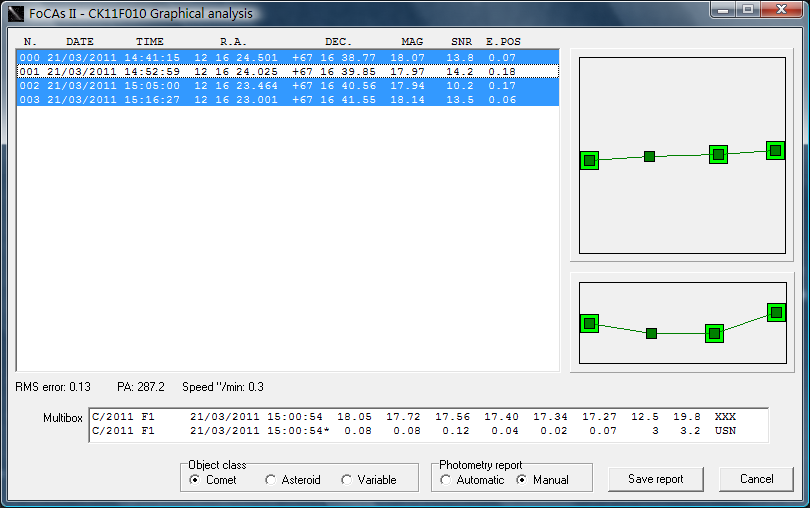
-
Copyright © Man-To
Hui
2011/03/22
2011 Mar 20
|
2011/03/21 14:42:14 UT
- 15:21:53 UT, 14" SCT f/6.9 + QHY9 CCD, BIN 2x2 90 sec x 9
exposure, north up and east left |
The following image
is 10x resized in order to extract details of the object. Based upon
scrutiny analysis of this image, I obtain potential coma's dia. 8",
and a tail in length of 5" in P.A. 275°. However, one cannot rule
out the case that it may well be artefact as well. More observations
from larger aperture may finally reveal the true nature of the
object.
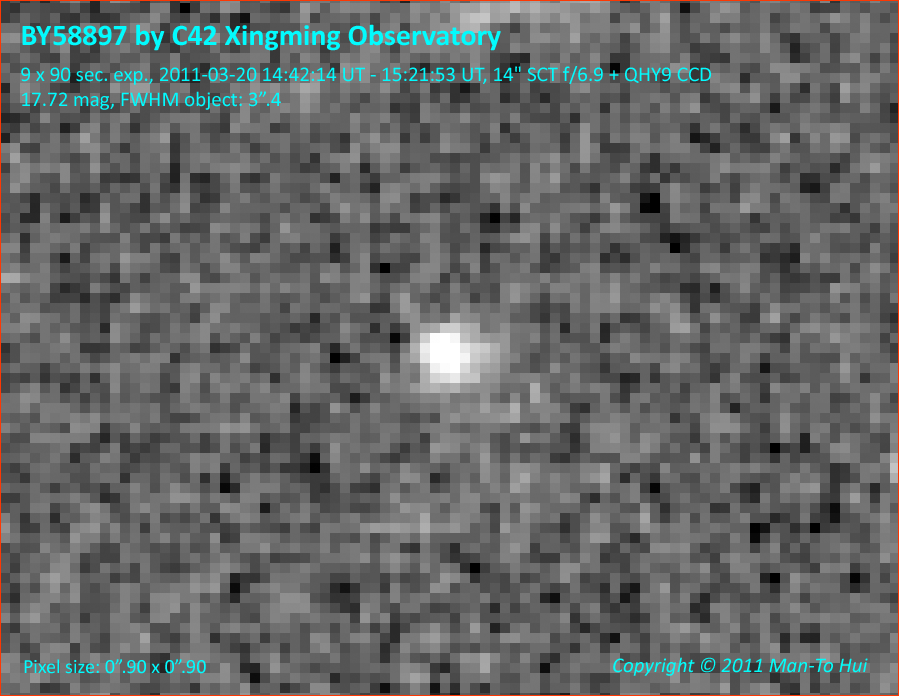
MPC observation computed with Astrometrica
using UCAC-3 star catalog in R band:
- COD C42
OBS X.Gao, M.-T. Hui
MEA M.-T. Hui
TEL 0.36-m f/6.9 Schmidt-Cassegrain + CCD
NET UCAC-3
BY58897 KC2011 03 20.61447 12 17 25.80 +67 14 50.0
18.3 R C42
BY58897 KC2011 03 20.62773 12 17 25.01 +67 14 52.2
18.4 R C42
BY58897 KC2011 03 20.63947 12 17 24.26 +67 14 53.7
17.8 R C42
----- end -----

-
- Gauss curve produced by
Astrometrica with USNO-A2.0. The total PSF is using an aperture circle of
5 x
5 pixel around the brightest
pixel. We can see the Gauss curve
in the right is as the computed ideal line and the
real pixels contributed around the ideal line. The Fit RMS,
which inlays under the Gauss curve, is the deviation from the
ideal line.
- I try to compute a seemingly appropriate
orbital solution for the object with employment of our astrometrical
measurements and measurements from other stations and observatories.
-
- Two reasonable solutions are obtained
insofar as totally 90 observations in three days are fed to FindOrb as
follows:
-
- [1] Constraint e=1
-
- Orbital elements:
BY58897
Perihelion 2013 Jan 23.871543 TT; Constraint: e=1
Epoch 2011 Mar 21.0 TT = JDT 2455641.5 Earth MOID: 0.6002
q 1.58097160 (2000.0)
P
Q
H 9.1 G 0.15 Peri. 198.07741
0.08989292 0.54313071
Node 85.23444 -0.77869437
0.56091769
e 1.0 Incl. 56.89995 -0.62093021
-0.62480426
From 90 observations 2011 Mar. 17-20; RMS error 0.545 arcseconds
# State vector (heliocentric ecliptic J2000):
# -3.605958877619 2.307669124967
5.806493283820 AU
# 3.022393115172 -6.566673346981
-5.457179093081 mAU/day
# MOIDs: Me 1.1313 Ve 0.8816 Ea 0.6002 Ma 0.1503
# MOIDs: Ju 3.6512 Sa 5.4899 Ur 7.1033 Ne 5.1085
# Elements written: 20 Mar 2011 20:06:17 (JD 2455641.337697)
# Full range of obs: 2011 Mar. 17-20 (99 observations)
# Find_Orb ver: Oct 11 2010 13:08:42
# Perturbers: 00000000 (unperturbed orbit)
# Tisserand relative to Earth: 1.94214
# Tisserand relative to Jupiter: 0.85142
# Tisserand relative to Neptune: 0.35418
# Vis:
BY58897&Epoch=20110321.000000&M=360.00000&e=1.0000000&a=1075059984.2320454&Peri=198.07742&Node=85.23444&Incl=56.89996&Eqnx=2000.0
# SkM:
&OE_EPOCH=2455641.500&OE_EC=1.000000&OE_QR=1.580972&OE_TP=2456316.371543&OE_OM=85.234443&OE_W=198.077419&OE_IN=56.899958&OE_H=9.1
-
- [2] Auto-solve mode:
-
- Orbital elements:
BY58897
Perihelion 2013 Feb 16.488864 TT = 11:43:57 (JD 2456339.988864)
Epoch 2011 Mar 21.0 TT = JDT 2455641.5 Earth MOID: 0.7603
M 356.72796
(2000.0) P
Q
n 0.00468444 Peri. 196.52836
0.08949044 0.54079919
a 35.3750855 Node
86.09746 -0.79234856
0.54745942
e 0.9506555 Incl.
56.96330 -0.60346930
-0.63861131
P 210.40 H
9.2 G 0.15 q 1.74556309
Q 69.0046079
From 90 observations 2011 Mar. 17-20; RMS error 0.541 arcseconds
# State vector (heliocentric ecliptic J2000):
# -3.550923584117 2.259038951657
5.684042876486 AU
# 2.741918370763 -6.617796025716
-4.899081196654 mAU/day
# MOIDs: Me 1.2936 Ve 1.0421 Ea 0.7603 Ma 0.3118
# MOIDs: Ju 3.4874 Sa 5.6206 Ur 6.1971 Ne 2.2662
# Elements written: 20 Mar 2011 20:08:23 (JD 2455641.339155)
# Full range of obs: 2011 Mar. 17-20 (99 observations)
# Find_Orb ver: Oct 11 2010 13:08:42
# Perturbers: 00000000 (unperturbed orbit)
# Tisserand relative to Earth: 2.04025
# Tisserand relative to Jupiter: 1.02912
# Tisserand relative to Neptune: 1.21692
# Vis:
BY58897&Epoch=20110321.000000&M=356.72797&e=0.9506556&a=35.3750855&Peri=196.52837&Node=86.09747&Incl=56.96330&Eqnx=2000.0
# SkM:
&OE_EPOCH=2455641.500&OE_EC=0.950656&OE_QR=1.745563&OE_TP=2456339.988864&OE_OM=86.097470&OE_W=196.528366&OE_IN=56.963302&OE_H=9.2
Since the arc is still too short it is
impossible to firmly assert which one is the closest solution to the reality.
- Photometry result computed with FOCAS II,
which processes images based upon the .LOG file of Astrometrica, by means of
Multibox method:
- COD C42
CATALOG: USNO A2.0 / CMC-14 - BAND: R
10x10 20x20 30x30
40x40 50x50 60x60
SNR SB
COD
OBJECT DATE
TIME +/- +/-
+/- +/- +/- +/-
N FWHM CAT
------------ ---------- -------- -----
----- ----- -----
----- ----- ----
---- ---
BY58897 20/03/2011
15:03:12 17.85 17.43 17.18 16.94 16.70 16.43
7.5 18.6 C42
BY58897 20/03/2011
15:03:12* 0.09
0.10 0.13 0.25
0.24 0.20
3 3.3 USN
FoCAs II - 17/03/2010
www.astrosurf.com/cometas-obs
es.groups.yahoo.com/group/Cometas_Obs
- Interpretation of the FOCAS II table
headings:
-
-
- Fisrt line:
-
- OBJECT,
DATE, TIME: refering to their original meanings respectively
-
- 10x10,
20x20 ... 60x60: the aperture sizes of photometry in term of
rectangle in arcsec that are used to measure an object's magnitude
-
- SNR:
the Signal-to-Noise Ratio for aperture photometry
-
- SB:
stars of faintest magnitude on the images used in data reduction with
the used star catalog in Astrometrica, rather than the stars of faintest
magnitude in the images
-
- COD:
MPC Code of the observatory
-
-
-
- Second line:
-
- +/-:
precisions of measurement
-
- N:
the number of used images for measurement
-
- FWHM:
Full-Width-Half-Maximum of total PSF, relevant to degree of seeing
-
- CAT:
the used star catalog in Astrometrica
-
-
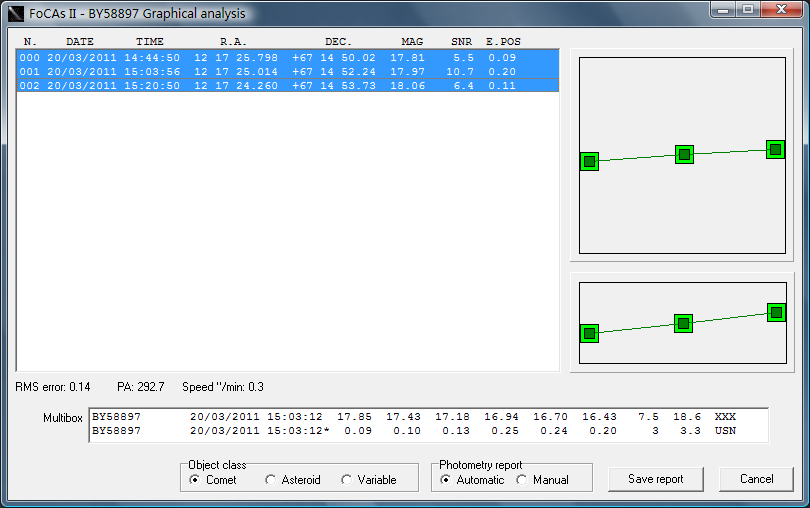
-
Copyright © Man-To
Hui
2011/03/20
Feel free to e-mail
me with any doubts or questions.
Top
Back...
-- Zurück...
Home







